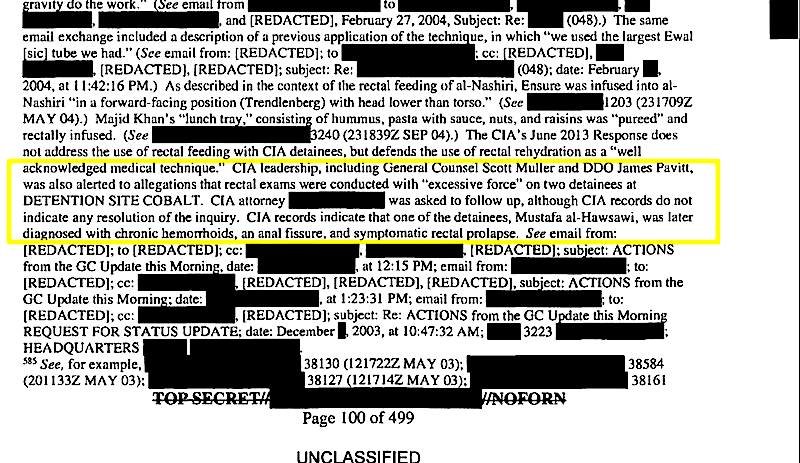Hawsawi, a Saudi, and four other men are awaiting a death-penalty trial for allegedly orchestrating the Sept. 11, 2001, terror attacks that killed nearly 3,000 people. He voluntarily missed Friday's hearing to rest up for the procedure.
An unclassified portion of the Senate Intelligence Committee's investigation of the CIA's Black Site program showed allegations that Hawsawi was subjected to rectal exams with "excessive force" before his 2006 transfer to Guantánamo and that at one point he had a "medical emergency" that the agency considered having treated in a foreign hospital.
On Saturday, the military was mum on the outcome of Hawsawi's Guantánamo surgery. Ruiz said he received few other details, aside from the fact that, once the anesthesia wore off, the Saudi was to be returned to Camp 7, Guantánamo's secret lock-up for former CIA Black Site captives — including Hawsawi and five others awaiting death-penalty trials.
The detention center spokesman, Navy Capt. John Filostrat, had no information to provide Saturday morning about the medical procedure carried out at the Navy base hospital, a 5- to 10-minute prison ambulance or prison van drive from the Detention Center Zone. He said by email, it was prison policy "not to discuss detainee medical issues."
Nor would Filostrat say whether a colorectal specialist was brought to this remote base to do the surgery, and whether, if so, others among the up-to 6,000 base inhabitants were able to benefit from the surgeon's presence. The base is run by the Navy, which has sailors and their families, about 2,000 Jamaican and Filipino Pentagon contract workers as well as an approximate 2,000-strong military and civilian staff at the prison of 61 war-on-terror captives.
Detention Center commanders have for years briefed reporters that their captives get commensurate medical care to soldiers and sailors; and that the Navy routinely brings in specialists to carry out some procedures.
Comment: In other words...none?
Hawsawi was captured in Rawalpindi, Pakistan, in March 2003 with the alleged mastermind of the 9/11 attacks, Khalid Sheik Mohammed, and was held by the CIA until his delivery to Guantánamo in September 2006. He is alleged to have helped the hijackers with money, Western clothing, travelers' checks and credit cards.
Hawsawi's lawyers had been litigating over conditions at the remote prison and, sought medical intervention to treat a rectal prolapse that has caused Hawsawi to bleed for more than a decade.
He has sat gingerly on a pillow at the war court since his first appearance in 2008. But the reason was not publicly known until release of a portion of the so-called Senate Torture Report on the CIA program in December 2014, which described agents using quasi-medical techniques called "rectal rehydration" and "rectal re-feeding."
"Mr. Hawsawi was tortured in the black sites. He was sodomized," Ruiz told reporters earlier in the week, advising them to "shy away from terms like rectal penetration or rectal rehydration because the reality is it was sodomy," he said. Since then, he said, he has had "to manually reinsert parts of his anal cavity" to defecate. "When he has a bowel movement, he has to reinsert parts of his anus back into his anal cavity," Ruiz said, which "causes him to bleed, causes him excruciating pain."
Families of eight people killed in the Sept. 11 terror attacks were on base at the time of the surgery, brought by the Pentagon to watch four days of pretrial hearings. One expressed disgust that a hearing was on "minutiae." Successive groups have told reporters they are eager to get on with the trial, and criticized the pretrial focus on torture.
Earlier in the week, Army Lt. Gen. Jennifer Williams, one of Hawsawi's attorneys, asked the trial judge, Army Col. James L. Pohl, to order the prosecution or CIA to give them the Saudi's complete medical records from across more than three years of spy agency custody.
Williams noted that CIA cables released under the Freedom of Information Act show that, in one instance in April 2003, Hawsawi was interrogated with "continuous sessions of water dousing, walling, attention grasps, facial holds, cramped confinement, and psychological pressures for 14 nonstop hours."
But defense teams preparing for trial have no medical records from that period, noting that Hawsawi also suffers cervical damage that may be linked to "walling" — a CIA technique that rammed a captive's head into a wall to break him for interrogation. Water dousing is described in the Senate Report as similar to water-boarding, a near-drowning torture technique.
The judge at one point questioned whether such medical records exist. "What we know from open-source material is that medical physicians at times were in place when these techniques were being done and when the torture was being committed," Hawsawi's Army lawyer replied.





Comment: Torture: The government's 'terrorists' within are just as bad, maybe worse, than the terrorists in the field. For Hawsawi, it took more than 10 years to repair this ongoing, painful damage.